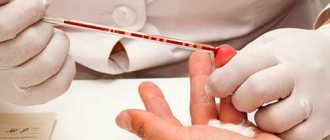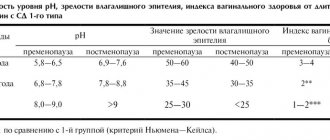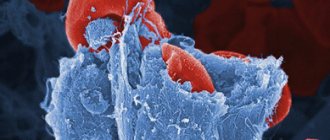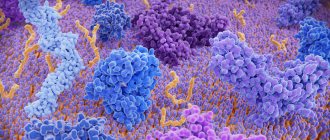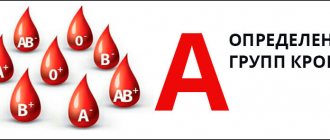Complexes with this research
Advanced anti-aging diagnostics in postmenopause Advanced monitoring of age-related changes during postmenopause RUB 29,230 Composition
Male anti-aging diagnostics Monitoring of key indicators in men aged 40+ RUB 13,300 Composition
Stress complex Assessment of the body's condition during stress 4,310 ₽ Composition
IN OTHER COMPLEXES
- Advanced women's anti-aging diagnostics RUB 28,680
- Healthy interest RUB 4,250
- Anti-aging diagnostics in postmenopause RUB 12,630
- Fitness monitoring 6,780 RUR
- Nutritionist recommends RUB 7,570
What is the atherogenic coefficient in a blood test?
The atherogenic coefficient is the balance of “good” cholesterol and total cholesterol, which in the future can go into a bound state (LDL), and represents their proportional ratio.
What is this coefficient? At a general, everyday level, everyone knows that there is “bad” (or LDL cholesterol) and “good” (HDL cholesterol) cholesterol. Complex molecules of good cholesterol are too large to be absorbed into tissues; they “collect” molecules of “bad” fatty alcohol and transport them to the liver for processing. On the contrary, “bad” cholesterol settles on the walls of blood vessels and forms plaques that narrow the lumen of the blood vessel and impair blood circulation. In addition, total cholesterol also circulates in the blood, that is, the substance in an unbound state.
At the moment, this is the most accurate indicator of the state of lipid (fat) metabolism in the body and assessing the risk of atherosclerosis and other cardiovascular diseases (although the role of fatty alcohol in the development of pathologies of this kind is controversial).
In addition, the definition of this indicator can be informative in the following cases:
- Diagnosis of thyroid and liver diseases;
- Controlling cholesterol dynamics (with drug therapy);
- During the initial preventive examination of the patient.
Detailed description of the study
Cholesterol (C) is a complex molecule that includes lipids (fats) and a polycyclic alcohol. This substance is necessary for humans, therefore it is synthesized by liver cells. In addition, some of the cholesterol comes from eating foods that contain animal fats.
The human need for cholesterol is dictated by its important role in many biological processes. This substance serves as a substrate for the formation of sex hormones (in both women and men) and bile acids, and is involved in the metabolism of vitamin D and the formation of cell membranes.
Once in the blood, cholesterol combines with special molecules - lipoproteins, in which they are delivered to organs and tissues, and can also be transported from cells back to the liver. Depending on the type of such compounds, cholesterol fractions are distinguished; their totality is designated as the lipid spectrum.
Low-density lipoproteins (LDL) carry cholesterol into tissues, including arteries, which creates the preconditions for the appearance of atherosclerotic plaques. Because of this, LDL-C is often labeled as “bad” or “harmful.” The higher the LDL level, the higher the risk of cardiovascular diseases and their complications: coronary heart disease, heart attack, cerebrovascular accident.
In contrast to LDL, cholesterol found in high-density lipoprotein cholesterol (HDL-C) is classified as “good” or “useful.” The advantage of HDL is that it transports lipids from blood vessels and organs back to the liver. Adequate HDL levels are essential for maintaining cardiovascular health.
To avoid the development of atherosclerosis, the ratio between total cholesterol and HDL cholesterol must be maintained at a certain level. This indicator is called the atherogenic index/coefficient (AC).
An increased atherogenic index means that there is an imbalance in the metabolism of fats in the person being examined, with a predominance of the “bad” cholesterol fraction. Low KA is associated with sufficient presence of HDL cholesterol in the body. It should be noted that the analysis does not show the reason for the identified changes.
The study serves as a complement to the standard biochemical blood test. It can be considered as one of the basic and easily accessible tools for predicting cardiovascular risk. Using the data obtained, your doctor will decide whether to lower your cholesterol levels.
Atherogenic Index or Atherogenic Coefficient
The atherogenic coefficient is an indicator that reflects the degree of risk of developing heart and vascular disease.
Synonyms Russian
Atherogenic index, cholesterol atherogenic coefficient, cholesterol atherogenic coefficient, AI, CA, CCA.
English synonyms
Cholesterol/HDL ratio.
What is this analysis used for?
To assess the risk of developing heart and vascular diseases.
When is the study scheduled?
- During routine medical examinations.
- When there are factors in a patient’s life that increase the risk of developing cardiovascular diseases.
What biomaterial can be used for research?
Venous blood.
How to properly prepare for research?
- 1-2 weeks before the study you should not disrupt your usual diet.
- Avoid physical and emotional stress for 30 minutes before the test.
- Do not smoke for 30 minutes before the test.
- It is recommended to stop eating 12 hours before the test (you can drink water).
- You should abstain from alcohol for 24 hours before the test.
- It is necessary to take a sitting position 5 minutes before the examination.
General information about the study
Atherogenicity coefficient is the ratio of “bad” cholesterol to “good” cholesterol, characterizing the risk of developing cardiovascular diseases.
Cholesterol (CH) is a fat-like substance vital to the body. It is involved in the formation of cell membranes of all organs and tissues of the body. Hormones are created on the basis of cholesterol, without which growth, development of the body and implementation of the reproductive function are impossible. Bile acids are formed from it, thanks to which fats are absorbed in the intestines.
Cholesterol is insoluble in water, so to move around the body it is “packed” into a shell consisting of special proteins - apoproteins. The resulting complex (“cholesterol + apoprotein”) is called a lipoprotein.
Several types of lipoproteins circulate in the blood, differing in the proportions of their components:
- very low density lipoproteins (VLDL),
- low density lipoproteins (LDL),
- high density lipoproteins (HDL).
LDL and VLDL are considered the “bad” types of cholesterol because they contribute to the formation of plaque in the arteries, which can lead to heart attack or stroke. HDL, on the other hand, is called “good” cholesterol because it removes excess amounts of low-density cholesterol from the walls of the blood vessel.
In the development of atherosclerotic plaques in blood vessels, not only an increase in the total amount of cholesterol in the blood is important, but also the ratio between “bad” and “good” cholesterol. This is what the atherogenicity coefficient reflects. It is calculated using the following formula: KA = (total cholesterol - HDL)/HDL.
Thus, in order to determine KA, it is necessary to know the level of total cholesterol and HDL.
The optimal atherogenicity coefficient is 2-3.
The atherogenicity coefficient is an indicative indicator. To more accurately assess the risk of developing atherosclerosis and heart and vascular diseases, it is better to use accurate values of total cholesterol, LDL and HDL.
What is the research used for?
The atherogenic coefficient test is used to assess the risk of developing atherosclerosis and problems with the heart and blood vessels.
Changes in the levels of “bad” and “good” cholesterol and their ratio in itself, as a rule, do not manifest any symptoms, so their timely determination is very important in the prevention of cardiovascular diseases.
When is the study scheduled?
The atherogenic index is usually part of the lipid profile, as are total cholesterol, HDL, LDL, VLDL and triglycerides. A lipidogram may be part of a standard set of tests during preventive examinations or taken more often if a person is prescribed a diet with limited animal fats and/or takes medications that lower lipid levels. In these cases, it is checked whether the patient reaches the target level of cholesterol values and, accordingly, whether his risk of cardiovascular diseases is reduced.
In addition, a lipid profile is prescribed more often if the patient’s life contains risk factors for developing cardiovascular diseases:
- smoking,
- for men over 45 years of age, for women over 55,
- high blood pressure (140/90 mmHg and above),
- high cholesterol or cardiovascular disease in family members (heart attack or stroke in an immediate male relative under 55 years of age or a woman under 65 years of age),
- coronary heart disease, previous myocardial infarction or stroke,
- diabetes,
- excess body weight,
- alcohol abuse,
- eating large amounts of food containing animal fats,
- low physical activity.
If a child has high cholesterol or heart disease, it is recommended that he or she undergo a lipid profile or total cholesterol test for the first time between the ages of 2 and 10 years.
What do the results mean?
Reference values: 2.2 -3.5.
A result above 3 indicates a predominance of “bad” cholesterol, which may be a sign of atherosclerosis.
To more accurately assess the risk of developing cardiovascular diseases, it is necessary to take into account all factors: cardiovascular diseases in the patient or his relatives, smoking, high blood pressure, diabetes, obesity, etc.
For people at high risk of circulatory disease, target total cholesterol levels are less than 4 mmol/L. To confidently talk about the likelihood of such diseases, you need to know your LDL level.
A decrease in KA has no clinical significance.
What can influence the result?
KA is increased:
- pregnancy (cholesterol should be tested at least 6 weeks after the birth of the child),
- long fasting,
- donate blood while standing,
- anabolic steroids, androgens, corticosteroids,
- smoking,
- eating food containing animal fats.
KA is reduced:
- donate blood while lying down,
- allopurinol, clofibrate, colchicine, antifungal drugs, statins, cholestyramine, erythromycin, estrogens,
- intense physical activity,
- a diet low in cholesterol and high in polyunsaturated fatty acids.
Important Notes
Lipid testing should be done when a person is relatively healthy. After an acute illness, heart attack, or surgery, you must wait at least 6 weeks before performing a lipid profile.
Who orders the study?
General practitioner, therapist, cardiologist.
References
- Kukharchuk, V.V., Ezhov, M.V., Sergienko, I.V. and others. Clinical recommendations of the Eurasian Association of Ardiologists (EAA) / National Society for the Study of Atherosclerosis (NOA) for the diagnosis and correction of lipid metabolism disorders for the prevention and treatment of atherosclerosis. Eurasian Journal of Cardiology, 2021. - T. 2. - P. 6-29.
- Quispe, R., Elshazly, M., Zhao, D. et al. Total cholesterol/HDL-cholesterol ratio discordance with LDL-cholesterol and non-HDL-cholesterol and incidence of atherosclerotic cardiovascular disease in primary prevention: The ARIC study. Eur J Prev Cardiol., 2021. - Vol. 27(15). - P. 1597-1605.
Increased atherogenicity coefficient, what to do?
If the results of laboratory tests reveal a high coefficient, this indicates that the body produces predominantly “bad” cholesterol. Despite the lack of evidence about the direct and main role of fatty alcohol in the formation of cardiovascular diseases and pathologies, it is not worth the risk. Measures should be taken immediately to normalize the indicator.
You can do this in two ways:
- Change your lifestyle and diet.
- Start taking specialized medications.
Lifestyle
The increase in the index is due to a number of reasons:
- Presence of bad habits (smoking, alcohol abuse, drug use). Psychoactive substances “inhibit” normal fat metabolism and disrupt fat synthesis.
- Sedentary lifestyle. Physical inactivity leads to stagnant processes. Fats and fatty complexes are synthesized too actively.
From this we can conclude that to normalize the index you need:
- Lead a more active lifestyle. Strong physical activity can normalize the concentration of cholesterol in the blood and lipid metabolism. A healthy person is recommended to do 4 sessions during the week, 35-40 minutes each. If you have a history of diseases, you should consult a doctor to exclude contraindications and select the optimal physical activity regimen.
- Give up bad habits.
Diet
It is advisable to limit consumption or completely avoid the following foods:
- Sausages;
- Fatty fermented milk products (sour cream, cream, butter);
- Products rich in trans fats (margarine, palm oil spreads, etc.)
On the contrary, you should include in your diet:
- Fish. Cod, hake, flounder and others. Frying should be avoided, giving preference to boiling.
- Nuts (almonds, walnuts). Nuts contain monosaturated fatty compounds and can reduce the amount of cholesterol in the blood.
- Fruits vegetables. Especially beets. Potatoes are not recommended.
- Chocolate and green tea.
- Garlic.
- Cereals.
As well as other products containing fats of vegetable rather than animal origin.
Read more: How to lower cholesterol at home, without drugs?
Taking medications is another way to reduce the atherogenic index. However, statins (cholesterol-lowering drugs) have many side effects and should be taken strictly on the advice of a doctor and in a very limited number of cases.
What influences the increase in the coefficient
The atherogenicity index can increase under the influence of the following factors:
- At the genetic level, if relatives have cardiovascular pathologies.
- Regular psycho-emotional stress, stressful situations.
- Overweight.
- Smoking, alcoholism, drug addiction.
- Endocrine diseases.
- Sedentary lifestyle, lack of physical activity, unhealthy diet.
- Long-term use of medications - immunosuppressants, hormones.
Elevated levels of bad cholesterol cause the development of the following pathologies:
- ischemia;
- angina pectoris;
- heart failure;
- heart attack;
- aortic aneurysm;
- thrombophlebitis;
- phlebeurysm;
- atherosclerosis;
- diseases of the thyroid gland, liver;
- diabetes.
But based on one analysis to identify the atherogenic coefficient, diagnoses are not made. To do this, you will need to undergo additional diagnostics.
What to do if the readings are elevated
If a high level of bad fat has been identified, you should immediately change your lifestyle and diet, and take specialized medications.
First of all, give up bad habits, alcoholic beverages, and drugs. All these factors contribute to the “inhibition” of normal fat metabolism and disruption of lipid synthesis. A sedentary lifestyle causes stagnant processes.
The most important thing is to normalize your diet. Avoid consuming large amounts of fatty, fried foods. Include cereals, fruits, vegetables, lean fish and meat in your diet. Drink more fluids and exercise. It is enough to do exercises every morning and evening. This will prevent stagnation.
Taking medications is an equally effective way to normalize bad cholesterol. They have a common name - statins. But taking medications should definitely be discussed with your doctor after a detailed examination. The drugs have side effects, so taking them on your own is strictly prohibited.
Triglycerides
Triglycerides are the most important source of energy for cells; they are derivatives of glycerol. Triglycerides enter the human body with food, then they are synthesized in adipose tissue, then in the liver and in the intestines. The level of triglycerides in a person’s blood directly depends on age. To diagnose atherosclerosis, as well as many other diseases, triglyceride analysis is used. Plant seeds, liver and adipose tissue contain triglycerides, which are an essential part of human food.
The ratio of good and bad cholesterol
There are “bad” (LDL) and “good” (HDL) fats (lipids). The molecules of healthy fats are large and cannot be absorbed into tissues on their own. Collecting molecules of “harmful” fat, they are transported to the liver for breakdown. Harmful fat can settle on the walls of blood vessels and form plaques. They narrow the lumens of blood vessels, thereby worsening blood circulation. The atherogenic coefficient is considered the most accurate indicator of the state of fat metabolism. With its help, you can assess the risk of developing atherosclerosis and other cardiovascular pathologies.
The formula for determining healthy and unhealthy fat looks like this:
The normal atherogenicity index varies from 2 to 2.5 units (women - no more than 3.2 units; men - no more than 3.5). The indicators above indicate atherosclerosis. There is nothing to worry about when the level drops. Such results are not significant from a medical point of view.
